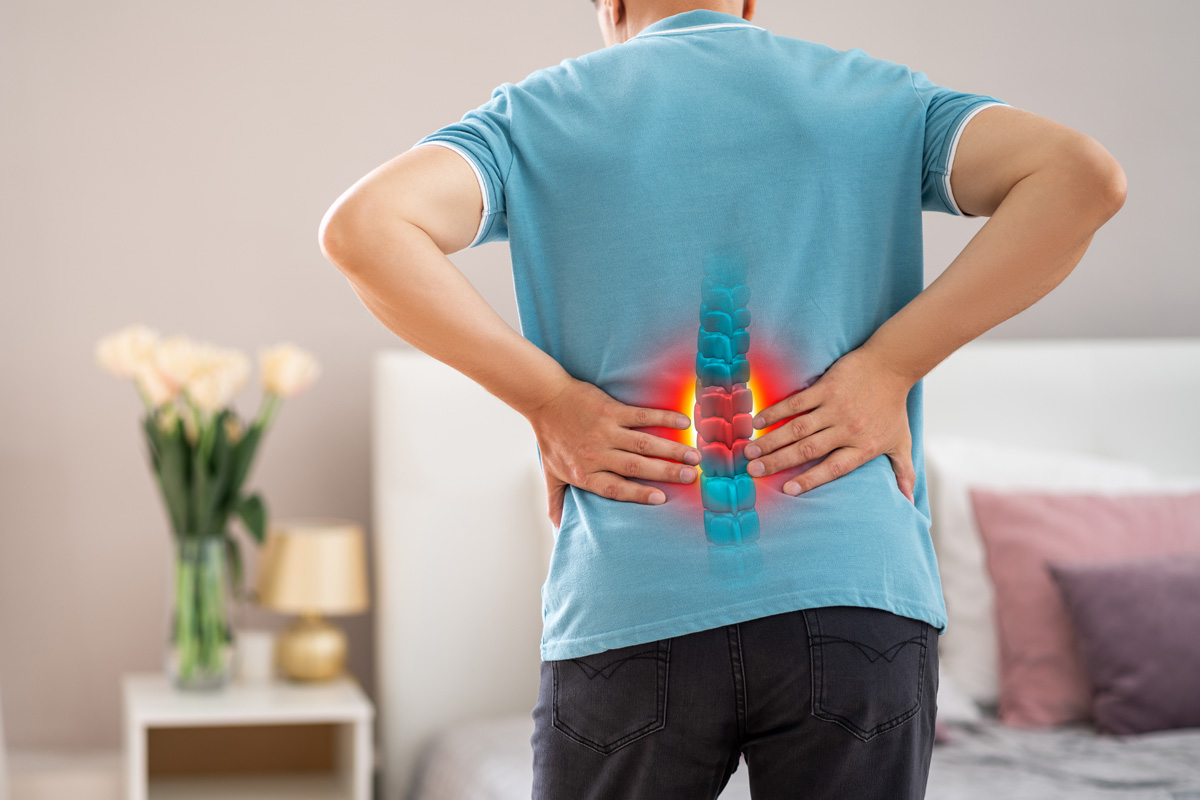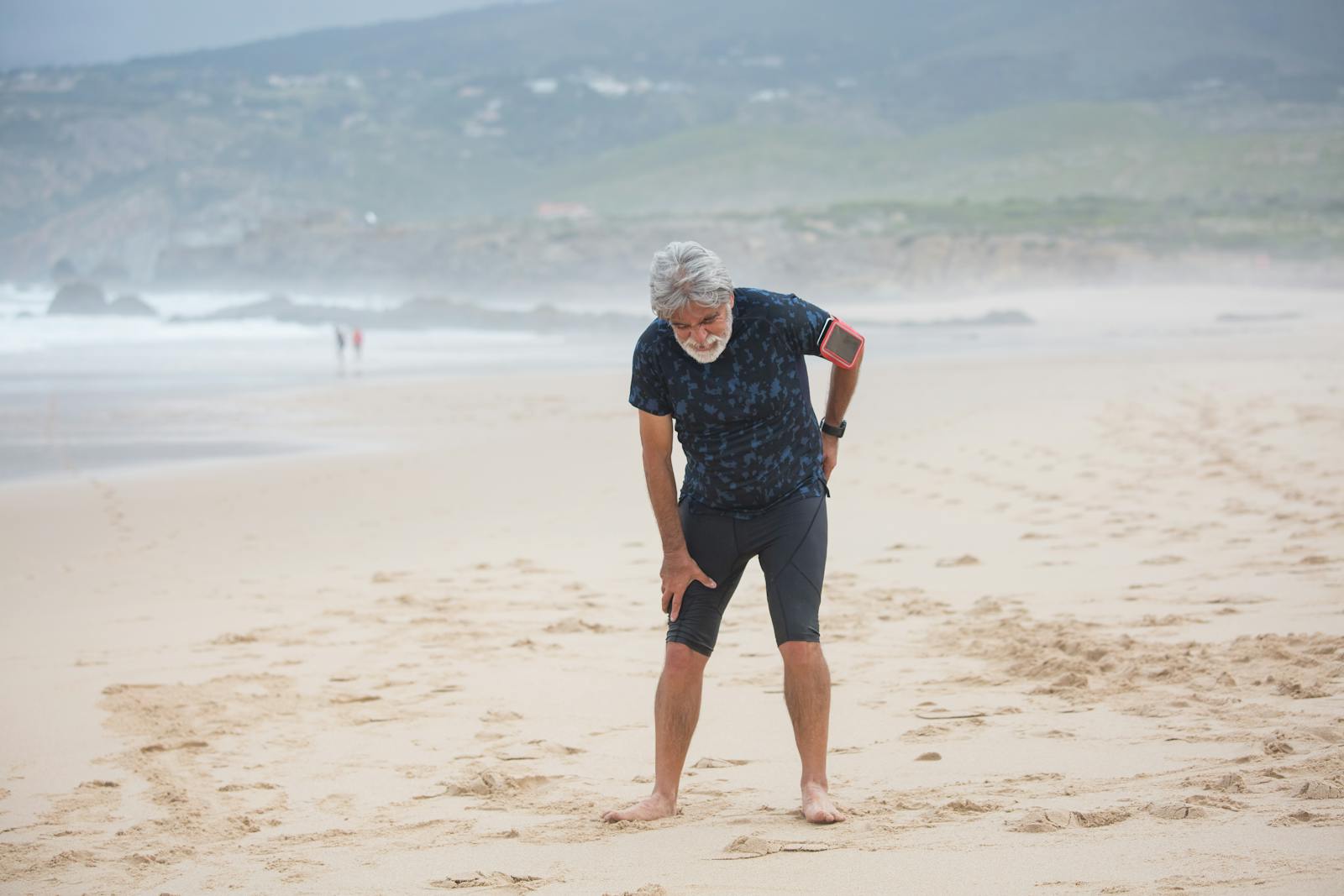The relationship between weather variations and pain has been a topic of interest in the medical community for decades. Specifically, the impact of weather changes on herniated disc pain has remained relatively controversial. Are these claims merely anecdotal or do fluctuations in weather indeed exacerbate this particular type of pain? Does the cold intensify the discomfort or is it the humidity that aggravates the symptoms? Let’s commence on a journey to unravel this intriguing conundrum, and perhaps even glean some insights that could lead to more effective pain management strategies.
Understanding Herniated Disc Pain
Exploring the complexity of herniated disc pain requires an understanding of the intricate structure of the spinal column, where the interplay between vertebrae, discs, and nerves can lead to this debilitating condition. The disc, a jelly-like cushion between vertebrae, can rupture or bulge outwards, pressing against nerves and causing acute discomfort.
The process of disc pain diagnosis involves identifying these structural anomalies through imaging techniques such as MRI or CT scans. However, the correlation between the severity of herniation and the intensity of pain is not always direct. Some patients with significant herniations experience minimal discomfort, while others with minor herniations report excruciating pain.
Surgical interventions, like discectomy or laminectomy, provide relief by removing the herniated portion of the disc or the lamina, which is the part of the vertebra covering the spinal canal. However, surgery is generally considered only when conservative treatments fail.
The subsequent analysis will explore the contentious claim of weather’s impact on herniated disc pain. Understanding this claim requires a grasp of the fundamental nature of herniated disc pain, its diagnosis, and possible interventions.
Common Myths About Herniated Discs
In the complex landscape of herniated disc pain, various misconceptions have emerged that often blur the line between fact and fiction. These myths, ranging from the cause to the treatment of herniated discs, can lead to ineffective management and unnecessary anxiety among patients. By scientifically scrutinizing and debunking these myths, we can provide a clearer understanding of herniated disc pain, aiding in more effective treatment decisions and patient education.
Discerning Fact From Fiction
To effectively manage herniated disc pain, it is essential to separate misconceptions from medical truths, confronting common myths that often circulate about this condition. The first myth, a key component of ‘pain perception myths‘, is the belief that pain intensity directly correlates with disc damage severity. However, scientific research indicates that pain levels in herniated disc cases can vary a lot, irrespective of disc damage extent. The second myth, part of ‘disc degeneration fiction’, posits that aging alone causes disc degeneration. Although aging is a factor, genetics, lifestyle, and injury history also play a significant role in influencing disc health. Lastly, the third myth suggests that all herniated discs require surgery; in fact, many cases respond well to conservative treatment methods.
Debunking Herniated Disc Myths
Addressing the multitude of myths surrounding herniated discs is an essential step towards a thorough understanding of this condition, facilitating informed decisions about treatment and management. A prevailing myth is that disc degeneration alone causes herniated discs. Scientific analysis, however, reveals multifactorial causes, including genetic predisposition, mechanical forces, and lifestyle factors. This nuanced understanding helps debunk the oversimplification that aging inevitably leads to disc herniation. Another common misconception is the supposed necessity of surgical treatment. Research indicates that non-surgical treatments, such as physiotherapy, medication, or lifestyle adjustments, can effectively manage many instances of herniated discs, further negating the ubiquity of this myth. These clarifications help in dispelling inaccuracies, promoting a more accurate perception of herniated discs.
Misconceptions in Disc Pain
While the previous discussion has debunked several misconceptions about herniated discs, it is essential to explore additional prevalent myths that often lead to misinformation and misunderstanding about disc pain.
- Pain perception myths: It’s widely believed that the intensity of disc pain directly correlates with the size of the herniation. However, research indicates this isn’t always the case. Some patients with large herniations experience minimal pain, while others with small herniations suffer intense discomfort.
- Disc degeneration misconceptions: Aging is often blamed solely for disc degeneration, yet other factors such as genetic predisposition and lifestyle can significantly contribute. Disc degeneration is not an inevitable part of aging.
- Surgery as the only solution: Many believe that surgery is the only effective treatment for herniated discs. However, conservative treatments like physical therapy can yield significant improvements.
Weather Changes and Body Pain
Numerous studies have indicated a significant correlation between shifting weather patterns and the exacerbation of body pain, particularly in individuals suffering from conditions such as herniated discs. This link is primarily understood through the lens of Pain Perception and Weather Psychology.
Pain Perception refers to the individual’s subjective experience of pain, which can be modulated by various external factors, including weather changes. Weather Psychology explores the impact of weather conditions on human behavior and psychology, including perceptions of pain. Specifically, fluctuating atmospheric pressure, humidity levels, and temperature shifts can trigger physiological responses, resulting in heightened sensitivity to pain.
Research suggests that these weather-induced physiological changes may lead to inflammation and swelling around the spinal nerves, triggering increased discomfort in individuals with herniated discs. It is also postulated that low barometric pressure may lead to the expansion of body tissues, exerting additional pressure on already sensitized nerves.
However, the psychological component, rooted in Weather Psychology, also plays a pivotal role. The anticipation of inclement weather or the mere thought of worsening pain can exacerbate the individual’s perception of discomfort. Hence, both objective weather changes and subjective psychological responses contribute to the complex relationship between weather patterns and body pain.
Correlation Between Cold Weather and Pain
Despite the complexities of the relationship between weather and pain, a significant correlation has been identified in scientific literature between cold weather and heightened pain, particularly among individuals with herniated discs. This can be attributed to a few key factors:
- Altered Pain Threshold: Cold temperatures may lower the threshold for pain perception variations. The body’s response to cold can exacerbate the nerve sensitization and inflammation associated with herniated discs, leading to increased discomfort.
- Muscular Tension: Cold weather often results in muscles becoming more tense, which can put additional strain on the areas around the herniated disc, thereby increasing pain.
- Weather Induced Inflammation: Cold weather can lead to vasoconstriction, the narrowing of blood vessels. This can amplify inflammation in areas already impacted by a herniated disc, further intensifying pain perception.
Does Rain Intensify Herniated Disc Pain?
Exploring the impact of rainfall on herniated disc pain reveals intriguing connections that merit scientific attention. A focus on rainfall patterns and their correlation with disc pain may provide insight into this crucial issue.
There are several theories as to why rain might intensify herniated disc pain. One centers on changes in atmospheric pressure that accompany rainfall, leading to increased pressure on the disc and consequent pain. Another theory suggests that the increased humidity during periods of rain can impact the hydration status of the discs, potentially increasing pain.
Disc hydration is a crucial element in maintaining the cushioning effect of the spinal discs. It has been proposed that changes in environmental humidity could affect disc hydration, thereby influencing disc health and pain levels. The suggestion that the higher humidity accompanying rainfall might cause the discs to swell and exert more pressure on surrounding nerves is an interesting one.
Research into this area, however, is sparse and results are inconsistent. Further rigorous, controlled studies are needed to establish a definitive relationship between rainfall patterns and the exacerbation of herniated disc pain. Until then, the influence of rainfall on disc pain remains a subject of scientific speculation.
The Science Behind Weather-Related Pain
Shifting our focus from the speculations around rainfall and disc pain, there exists a broader scientific domain that investigates the association between weather conditions and pain, particularly in the context of herniated discs. This domain probes into how various environmental factors – temperature, humidity, barometric pressure – may interact with our pain perception and response.
- Temperature: Changes in temperature can affect the body’s pain receptors. Cold weather may lead to constriction of blood vessels, reducing blood flow to the affected area and thereby increasing pain sensitivity. Conversely, warmer climates might provide relief by promoting blood circulation.
- Humidity: High humidity can exacerbate pain in some individuals. The theory suggests that increased moisture in the air might lead to swelling in the body tissues, causing discomfort in herniated disc areas.
- Barometric Pressure: Low pressure often precedes rain or stormy weather. Some scientists theorize that a decrease in atmospheric pressure could allow body tissues to expand, pressing against nerves and escalating pain.
These factors, alongside individual climate adaptation, can play a substantial role in modulating the subjective experience of pain. Hence, understanding these mechanisms might offer novel avenues for managing herniated disc pain.
Research Studies on Weather and Pain
Numerous research studies have explored the intriguing correlation between weather conditions and pain, presenting compelling evidence that lends credibility to the subjective experiences of individuals suffering from herniated disc pain. These investigations have meticulously analyzed Pain Perception Variations, revealing that changes in atmospheric conditions can greatly affect pain intensity.
One groundbreaking study demonstrated a strong correlation between cold, damp conditions and exacerbated pain symptoms in patients with herniated discs. The research, focusing on the Global Climate Impact, suggested that regions with colder, more volatile weather patterns tend to have higher rates of herniated disc discomfort.
Another empirical investigation provided robust evidence that rapid changes in barometric pressure can trigger pain flare-ups. This study’s results indicate that individuals with herniated discs may experience heightened pain perception during weather shifts, such as the shift from high to low pressure systems.
Individual Differences in Weather Sensitivity
The examination of individual differences in weather sensitivity offers an intricate layer to our understanding of weather’s impact on herniated disc pain. Personal weather sensitivities and weather impact variations represent two key factors that may substantially affect the interplay between meteorological conditions and pain severity in patients. A thorough analysis of these factors can elucidate the extent to which individual physiological and psychological differences may modulate the weather-pain relationship.
Personal Weather Sensitivities
In examining the impact of weather on herniated disc pain, individual differences in weather sensitivity play a significant role. Personal weather sensitivities are largely influenced by three major factors:
- Climate adaptations: Individuals residing in different climates adapt differently to weather changes. Hence, a person accustomed to a tropical climate may experience more discomfort during a cold spell compared to someone living in a colder region.
- Personal anecdotes: These influence perceptions of weather’s impact on pain. An individual may associate worsening pain with rainy weather based on past experiences.
- Physical and physiological differences: Varied pain thresholds and physiological responses to weather changes can lead to discrepancies in pain experiences.
Understanding these factors is essential in evaluating the relationship between weather and herniated disc pain.
Weather Impact Variations
Given these individual differences in weather sensitivity, the impact of specific weather conditions on herniated disc pain can greatly vary among individuals. This variation in response is often seen as a result of unique pain triggers and the stage of disc rehabilitation in each person. Certain atmospheric conditions, such as cold or damp weather, may exacerbate pain in some, while others find their symptoms worsen in hot, humid conditions. These variations could be due to individual physiological characteristics, emotional state, or the specific location and severity of the herniation. It is, accordingly, critical for research to account for these individual differences when investigating the weather’s impact on herniated disc pain, to inform patient-centred pain management strategies.

Ways to Manage Herniated Disc Pain
Understanding the most effective strategies to manage herniated disc pain can greatly enhance the quality of life for those affected, as it requires a holistic approach that encompasses various medical, physical, and lifestyle adjustments. The benefits of specific interventions, namely exercise and dietary adjustments, will be discussed in this section.
- Exercise Benefits: Regular physical activity is important in managing herniated disc pain. Exercise helps in strengthening the muscles that support the spine, reducing pressure on the discs. It also improves flexibility and posture, reducing the likelihood of further injury. Practices like yoga and Pilates, which focus on core strength and flexibility, can be particularly beneficial.
- Dietary Adjustments: A balanced diet plays a significant role in managing disc pain. Consuming foods rich in anti-inflammatory properties, like fruits, vegetables, and lean proteins, can help reduce inflammation around the herniated disc. A diet high in fiber can prevent constipation, which often exacerbates disc pain due to straining.
- Medical Interventions: Apart from lifestyle modifications, medical treatments like pain medication, physical therapy, or in severe cases, surgery, may be required. The best approach often involves a combination of these methods, tailored to the individual’s specific needs.
Can Weather Forecasts Help Plan Pain Management?
In investigating the intersection of weather forecasts and pain management for herniated disc conditions, it is essential to contemplate the potential influence of meteorological factors on pain levels. By understanding the correlation between weather patterns and pain intensity, medical professionals can incorporate this data into the design of thorough, personalized pain management strategies. This approach could potentially enhance patient comfort and improve the efficacy of treatments during periods of unfavorable weather conditions.
Weather Influence on Pain
The potential correlation between weather patterns and the exacerbation of herniated disc pain suggests that meteorological forecasts could serve as a valuable tool in strategizing effective pain management plans.
- Pain Perception: Fluctuations in temperature, humidity, and barometric pressure could potentially influence the perception of pain. For instance, cold and damp conditions might trigger increased sensitivity, leading to heightened discomfort.
- Seasonal Affects: Each season brings different weather patterns that may intensify pain symptoms. Winter’s cold and damp conditions or summer’s oppressive heat could exacerbate disc pain.
- Weather Forecasts: By understanding the role weather plays in pain perception, individuals suffering from herniated discs could potentially use weather forecasts to anticipate and better manage their pain episodes.
This approach requires further scientific exploration to validate its efficacy.
Pain Management Strategies
Given the potential correlation between weather conditions and herniated disc pain, it is plausible to ponder the feasibility of utilizing weather forecasts as an integral part of pain management strategies. This could potentially allow for preemptive measures such as timely administration of pain medication options and implementation of alternative therapies. It is important to understand the meteorological triggers for pain in order to make this concept viable. For example, if lower temperatures and high humidity levels are linked to increased pain, then colder, wet days could indicate a need for increased pain management interventions. The efficacy of this approach would be predicated on a detailed, patient-specific understanding of the interaction between atmospheric conditions and discogenic pain. Further research is needed to validate this hypothesis.
Separating Fact From Fiction: Final Thoughts
Often, misunderstandings about the impact of weather on herniated disc pain stem from anecdotal experiences rather than robust scientific evidence. The influence of weather on pain perception and disc deterioration, for instance, may be overstated due to personal experiences and pre-existing beliefs.
To cut through the noise, it is important to take into account three key points:
- The complexity of pain perception: Pain is a multifaceted experience, influenced by an array of physiological, psychological, and environmental factors. It is important and necessary to take into account variations in herniated disc pain solely to weather changes.
- The multifactorial nature of disc deterioration: Disc degeneration is a complex process involving genetic factors, aging, mechanical stress, and possibly, environmental factors like climate. To single out weather as the main culprit may be misleading.
- The need for more rigorous, scientific studies: While some studies suggest a link between weather changes and increased pain, the evidence remains inconclusive. More research is needed to confirm or refute this connection definitively.
Frequently Asked Questions
What Are the Symptoms of a Herniated Disc?
Symptoms of a herniated disc include lower back pain, numbness, tingling, and weakness in the affected area. Disc degeneration causes can be aging or injury, emphasizing the importance of herniated disc prevention strategies.
Can Certain Physical Activities Exacerbate Herniated Disc Pain?
Yes, certain physical activities can exacerbate herniated disc pain. The impact of exercise, especially with improper posture, can stress the spine, potentially worsening symptoms. So, it’s important to maintain correct posture during any physical activity.
Are There Certain Dietary Habits That Can Affect Herniated Disc Pain?
Dietary habits can indeed impact herniated disc pain. Maintaining proper hydration is essential for disc health. Additionally, incorporating anti-inflammatory foods into your diet can mitigate inflammation, potentially reducing disc-related pain.
How Does Stress Impact Herniated Disc Pain?
Stress can exacerbate herniated disc pain through muscle tension and inflammation. Implementing stress management techniques can mitigate this impact, highlighting the important interplay between physical conditions and mental health in managing such chronic pain conditions.
What Surgical Treatments Are Available for Herniated Disc Pain?
Several surgical treatments for herniated disc pain include discectomy, laminectomy, and spinal fusion. The recovery timeline varies, but post-operation care typically involves physical therapy, medication management, and lifestyle modifications to promote healing and prevent recurrence.


